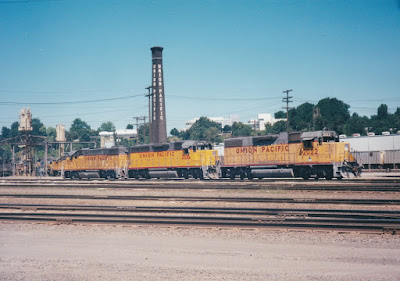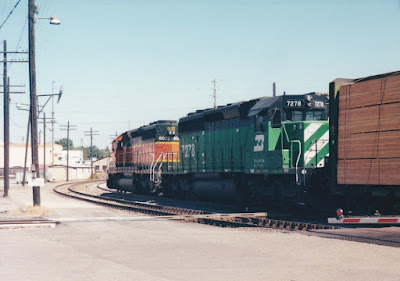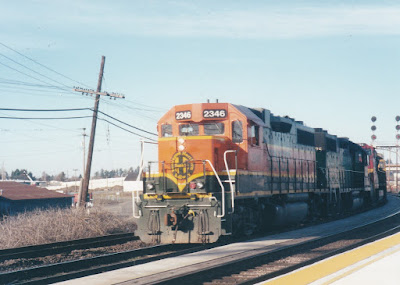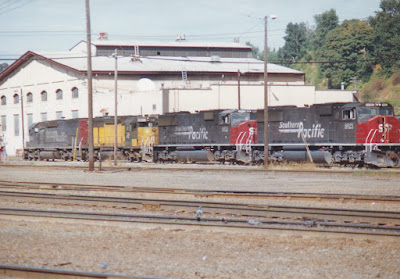I took these pictures in August of 2000. First, at Union Pacific's Albina Yard in Portland, Oregon, is Union Pacific #9408, a 4,135-horsepower Dash 8-41CW that was built by General Electric in November 1990.
Here is a trio of Union Pacific 2,000-horsepower GP38-2s, which all have different histories. On the right is Union Pacific #2022, which was built new for Union Pacific by the Electro-Motive Division of General Motors in April 1974. On the left is Union Pacific #2171, which was built by the Electro-Motive Division of General Motors in January 1980 as Missouri Pacific #2171. After the Missouri Pacific was merged into the Southern Pacific in 1982, this locomotive became Union Pacific #2171 on October 8, 1993. Finally, in the center is Union Pacific #2530, which has a more complicated history that deserves a closer look.
Union Pacific #2530 was originally built by the Electro-Motive Division of General Motors in January 1966 as Illinois Central #3026, a 3,000-horsepower GP40 without dynamic brakes. On August 10, 1972, the Illinois Central merged with the Gulf, Mobile & Ohio to form the Illinois Central Gulf, and this locomotive became Illinois Central Gulf #3026. After being retired by ICG, the locomotive was acquired by Helm Financial Corporation, reconditioned with dynamic brakes added, and leased to Union Pacific, becoming Union Pacific #853 on May 26, 1989. In 1998 it was returned to Helm Financial, was rebuilt by Boise Locomotive Company of Boise, Idaho, into a 2,000-horsepower GP38-2, and again leased to Union Pacific, becoming Union Pacific #2530 on August 20, 1998. When it was rebuilt from a GP40 to a GP38-2, its turbocharger was removed and an air filter box was installed in front of the dynamic brake housing, but it otherwise still resembles a pre-Dash 2 GP40, with three radiator fans, no water level sight glass below the radiators, and no shock absorbers on the trucks.
Leading a northbound freight train fast the Amtrak depot in Vancouver, Washington, is Burlington Northern Santa Fe #2880, a GP39M that was originally built by the Electro-Motive Division of General Motors in December 1964 as Cotton Belt (St. Louis Southwestern) #767, a 2,500-horsepower GP35. After 1965 it was renumbered to Cotton Belt #6507. Retired on April 15, 1987, it was sold on August 16, 1988 to Wilson Rail Services, then resold later that month to Morrison-Knudsen of Boise, Idaho, who rebuilt it into 2,300-horsepower GP39M Burlington Northern #2880 in February 1989. Following the merger of the Burlington Northern and the Atchison, Topeka & Santa Fe on September 12, 1995, this locomotive became Burlington Northern Santa Fe #2880, and had its headlight lowered into the nose following Santa Fe practice.
Southern Pacific #8165 is a 4,380-horsepower Dash 9-44CW that was built by General Electric in October 1994.
Spliced between a Burlington Northern Santa Fe Dash 9-44CW and a former Atchison, Topeka & Santa Fe (now BNSF) SD45-2 are Burlington Northern #6845 & #8153, 3,000-horsepower SD40-2s that were built by the Electro-Motive Division of General Motors in July 1978 and July 1980, respectively. Burlington Northern #6845 was built as St. Louis-San Francisco (SLSF, also known as the Frisco) #955. The Frisco was merged into the Burlington Northern on November 21, 1980, and the locomotive became Burlington Northern #6845.
Leading a freight train from Portland to head east up the Columbia River Gorge, Burlington Northern Santa Fe #8022 is a 3,000-horsepower SD40-2 that was built by the Electro-Motive Division of General Motors in March 1978. Following the merger of the Burlington Northern and the Atchison, Topeka & Santa Fe on September 12, 1995, this locomotive became Burlington Northern Santa Fe #8022, and had its headlight lowered into the nose following Santa Fe practice.
The trailing unit in the freight train, Burlington Northern #7278 is a 3,000-horsepower SD40-2 that was built by the Electro-Motive Division of General Motors in March 1980.


























































